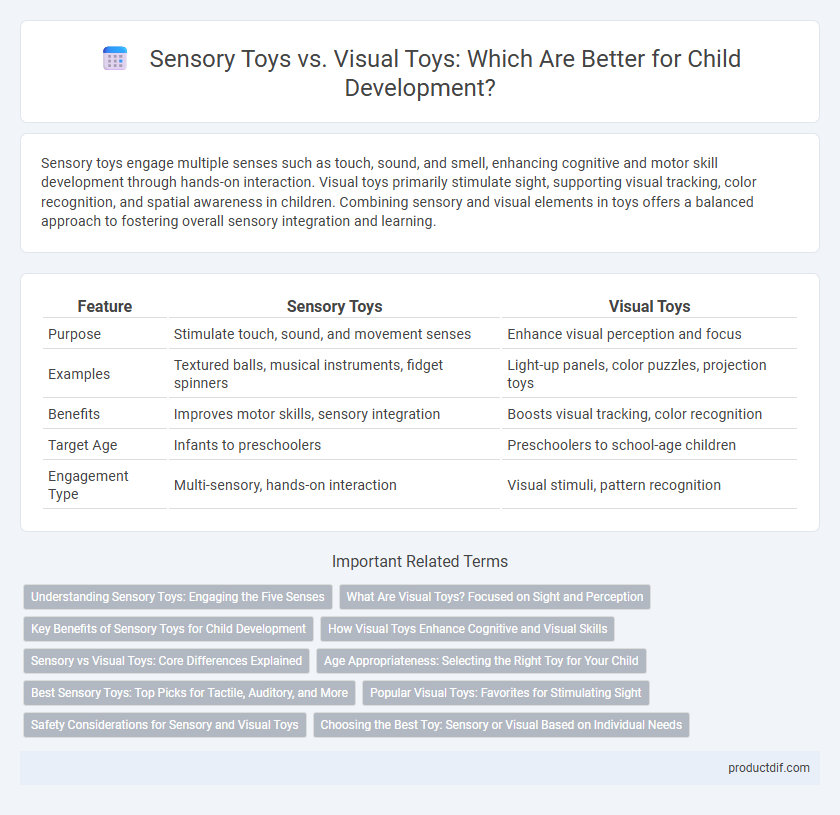Sensory toys engage multiple senses such as touch, sound, and smell, enhancing cognitive and motor skill development through hands-on interaction. Visual toys primarily stimulate sight, supporting visual tracking, color recognition, and spatial awareness in children. Combining sensory and visual elements in toys offers a balanced approach to fostering overall sensory integration and learning.
Table of Comparison
| Feature | Sensory Toys | Visual Toys |
|---|---|---|
| Purpose | Stimulate touch, sound, and movement senses | Enhance visual perception and focus |
| Examples | Textured balls, musical instruments, fidget spinners | Light-up panels, color puzzles, projection toys |
| Benefits | Improves motor skills, sensory integration | Boosts visual tracking, color recognition |
| Target Age | Infants to preschoolers | Preschoolers to school-age children |
| Engagement Type | Multi-sensory, hands-on interaction | Visual stimuli, pattern recognition |
Understanding Sensory Toys: Engaging the Five Senses
Sensory toys stimulate the five senses--touch, smell, taste, sight, and hearing--promoting cognitive development and sensory integration in children. These toys often include textured materials, scented elements, sound-producing features, and vibrant colors to actively engage multiple sensory pathways. In contrast, visual toys primarily focus on sight, using bright colors and shapes to enhance visual perception but lack the multi-sensory engagement offered by sensory toys.
What Are Visual Toys? Focused on Sight and Perception
Visual toys stimulate children's sight and perception by incorporating bright colors, patterns, and shapes that engage their visual processing skills. These toys, such as light-up blocks, kaleidoscopes, and picture books, enhance hand-eye coordination and help develop spatial awareness. By focusing on visual stimuli, these toys support cognitive growth through recognition, tracking, and differentiation of colors and forms.
Key Benefits of Sensory Toys for Child Development
Sensory toys enhance child development by stimulating multiple senses such as touch, sound, and smell, promoting cognitive growth and fine motor skills. Unlike visual toys that primarily engage sight, sensory toys support emotional regulation and social interaction through tactile and auditory experiences. These toys contribute to sensory integration, aiding children with developmental delays or sensory processing disorders to better navigate their environment.
How Visual Toys Enhance Cognitive and Visual Skills
Visual toys enhance cognitive and visual skills by stimulating eye-hand coordination, spatial awareness, and focus through engaging patterns, colors, and shapes. These toys promote mental development by encouraging problem-solving, memory retention, and attention to detail in children. Research shows that interactive visual play supports neural connections in the brain, fostering early visual perception and cognitive growth.
Sensory vs Visual Toys: Core Differences Explained
Sensory toys stimulate multiple senses such as touch, sound, and smell, promoting cognitive and motor skill development through hands-on interaction and sensory integration. Visual toys primarily engage sight and focus on colors, shapes, and patterns to enhance visual perception and attention to detail. Understanding the core differences between sensory and visual toys helps parents and educators choose appropriate tools that support specific developmental goals.
Age Appropriateness: Selecting the Right Toy for Your Child
Sensory toys, such as textured balls, scented playdough, and auditory rattles, are ideal for infants and toddlers aged 0-3 years as they encourage exploration through touch, smell, and sound, supporting early cognitive and motor skill development. Visual toys, like colorful picture books and light-up puzzles, suit preschoolers aged 3-5 years by enhancing visual perception and problem-solving abilities. Choosing age-appropriate sensory or visual toys ensures optimal developmental benefits, promoting fine motor skills and sensory integration tailored to a child's specific growth stage.
Best Sensory Toys: Top Picks for Tactile, Auditory, and More
Best sensory toys engage multiple senses through tactile textures, auditory sounds, and interactive features that strengthen fine motor skills and cognitive development. Popular picks include textured fidget spinners for tactile stimulation, musical instruments like mini drums or xylophones for auditory engagement, and multi-sensory activity cubes combining touch, sound, and visual elements. These toys support sensory processing and provide immersive, hands-on learning experiences crucial for early childhood growth.
Popular Visual Toys: Favorites for Stimulating Sight
Popular visual toys such as kaleidoscopes, light-up building blocks, and holographic puzzles effectively stimulate sight by engaging children with vibrant colors and dynamic patterns. These toys enhance visual tracking, color recognition, and spatial awareness, supporting cognitive and sensory development. Choosing visually stimulating toys tailored to a child's age can optimize visual learning and creativity.
Safety Considerations for Sensory and Visual Toys
Safety considerations for sensory toys prioritize non-toxic materials and hypoallergenic properties to prevent allergic reactions and skin irritation in children. Visual toys require secure construction without small detachable parts to avoid choking hazards and use non-toxic, fade-resistant paints to ensure long-term safety and durability. Both types of toys should comply with ASTM F963 and EN71 safety standards to guarantee child-safe design and manufacturing.
Choosing the Best Toy: Sensory or Visual Based on Individual Needs
Choosing the best toy depends on individual developmental needs, where sensory toys enhance tactile, auditory, and olfactory stimulation, promoting fine motor skills and cognitive growth. Visual toys focus on colors, shapes, and movement to boost visual tracking, pattern recognition, and spatial awareness. Selecting between sensory and visual toys requires assessing a child's specific sensory preferences and developmental goals to maximize engagement and learning outcomes.
Sensory toys vs visual toys Infographic

 productdif.com
productdif.com